
Natcho Aguirre, Santa Clara, Mexico, is a black and white photograph taken by Henri Cartier-Bresson in 1934, while in a travel to Mexico.

Natcho Aguirre, Santa Clara, Mexico, is a black and white photograph taken by Henri Cartier-Bresson in 1934, while in a travel to Mexico.
The picture appears staged, but its context and significance are left unexplained. It depicts to the left an anonymous man, with his face cut out and only partially visible, exposing his bare chest covered by his crossed arms, with his hands held up in fists, while his pants are partially unzipped. The man seems to be contorting in either agony or ecstasy, in a somewhat Christ-like pose, like if he were protecting or piercing his breasts. Its visible at his right a shelving cabinet with two groups of shoes. [1]
The enigmatic and erotic composition, with the juxtaposition of apparently unrelated elements demonstrates the influence of Surrealism and the notion of "convulsive beauty", exposed by André Breton, in the artist work, like also Cartier-Bresson's love of geometric forms. [2] [3]
There are prints of this photograph in several public collections, including the Henri Cartier-Bresson Foundation, in Paris, the Metropolitan Museum of Art, in New York, and the National Gallery of Australia, in Canberra. [4]

Henri Cartier-Bresson was a French artist and humanist photographer considered a master of candid photography, and an early user of 35mm film. He pioneered the genre of street photography, and viewed photography as capturing a decisive moment.
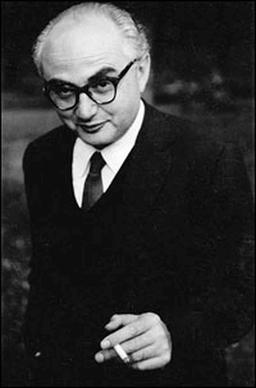
David Seymour, or Chim, was a Polish photographer and photojournalist.
Martin Munkácsi was a Hungarian photographer who worked in Germany (1928–1934) and the United States, where he was based in New York City.
Beaumont Newhall was an American curator, art historian, writer, photographer, and the second director of the George Eastman Museum. His book The History of Photography remains one of the most significant accounts in the field and has become a classic photographic history textbook. Newhall was the recipient of numerous awards and accolades for his accomplishments in the study of photo history.
Raghubir Singh (1942–1999) was an Indian photographer, most known for his landscapes and documentary-style photographs of the people of India. He was a self-taught photographer who worked in India and lived in Paris, London and New York. During his career he worked with National Geographic Magazine, The New York Times, The New Yorker and Time. In the early 1970s, he was one of the first photographers to reinvent the use of color at a time when color photography was still a marginal art form.
Christopher David Killip was a Manx photographer who worked at Harvard University from 1991 to 2017, as a Professor of Visual and Environmental Studies. Killip is known for his black and white images of people and places especially of Tyneside during the 1980s.
Fazal Sheikh is an artist who uses photographs to document people living in displaced and marginalized communities around the world.
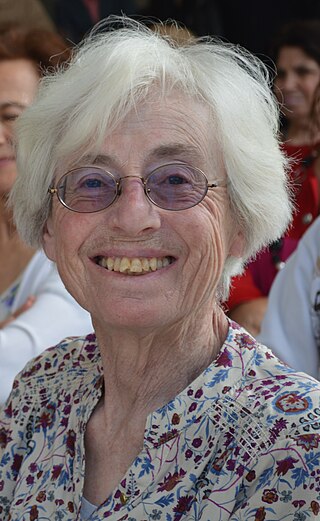
Colette Álvarez Urbajtel was a French-Mexican photographer, whose work, mostly of everyday life, was in black-and-white until 1990. She is the widow of Mexican photographer Manuel Álvarez Bravo, who taught her until she became a photographer in her own right. Her work has been exhibited extensively both in Mexico and abroad. It has been recognized with membership in the Salón de la Plástica Mexicana, two retrospectives and has been featured in several books and magazines.
Humanist Photography, also known as the School of Humanist Photography, manifests the Enlightenment philosophical system in social documentary practice based on a perception of social change. It emerged in the mid-twentieth-century and is associated most strongly with Europe, particularly France, where the upheavals of the two world wars originated, though it was a worldwide movement. It can be distinguished from photojournalism, with which it forms a sub-class of reportage, as it is concerned more broadly with everyday human experience, to witness mannerisms and customs, than with newsworthy events, though practitioners are conscious of conveying particular conditions and social trends, often, but not exclusively, concentrating on the underclasses or those disadvantaged by conflict, economic hardship or prejudice. Humanist photography "affirms the idea of a universal underlying human nature". Jean Claude Gautrand describes humanist photography as:
a lyrical trend, warm, fervent, and responsive to the sufferings of humanity [which] began to assert itself during the 1950s in Europe, particularly in France ... photographers dreamed of a world of mutual succour and compassion, encapsulated ideally in a solicitous vision.
Peter Johnston Galassi is an American writer, curator, and art historian working in the field of photography. His principal fields are photography and nineteenth-century French art.

Behind the Gare Saint-Lazare is a black and white photograph taken by French photographer Henri Cartier-Bresson in Paris in 1932. The photograph has been printed at variable dimensions; the print donated by Cartier-Bresson to the Museum of Modern Art is listed at 35.2 × 24.1 cm. It is one of his best known and more critically acclaimed photographs and became iconic of his style that attempted to capture the decisive moment in photography. The photograph was considered one of the 100 most influential pictures of all time by Time magazine.

Hyères, France is a black and white photograph taken by Henri Cartier-Bresson in 1932. It is one of the photographs from the year when he started taking photography more professionally. He took then many pictures in France and in other countries, like Italy, Spain, Morocco and Mexico, with his portable Leica camera.
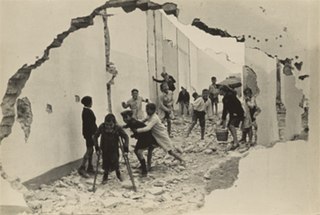
Seville, Spain is a black and white photograph taken by Henri Cartier-Bresson in 1933. He traveled through Spain in 1933, a trip which he documented with many pictures. He took this photograph in Seville, and was one of several that he captured in the same location.
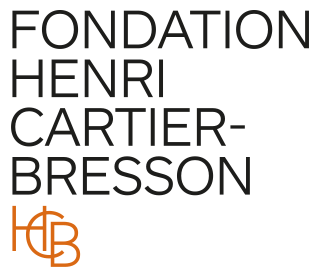
The Henri Cartier-Bresson Foundation, also known as Fondation HCB, is an art gallery and non-profit organisation in Paris that was established to preserve and show the work of Henri Cartier-Bresson and Martine Franck, and show the work of others. It was set up in 2003 by the photographer and painter Cartier-Bresson, his wife, also a photographer, Franck, and their daughter, Mélanie Cartier-Bresson.

Gold Rush, Shanghai, also known by other titles like Gold Rush. The Last Days of Kuomintang, Shanghai, is a black and white photograph taken by Henri Cartier-Bresson in 1948.
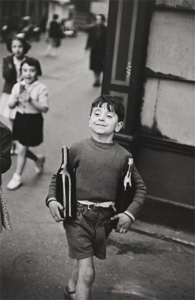
Rue Mouffetard, Paris, is a black and white photograph taken by Henri Cartier-Bresson in a Paris street in 1954.

Gestapo Informer Recognized by a Woman She Had Denounced, full title Gestapo Informer Recognized by a Woman She Had Denounced, Deportation Camp, Dessau, Germany, is a black and white photograph taken by Henri Cartier-Bresson in 1945. It is one of the most famous post-World War II pictures.

Juvisy, France, with the French title of Dimanche sur les Bords de Marne, Juvisy, is a black and white photograph taken by Henri Cartier-Bresson in 1938. The picture shows his influence and formation in painting and went to become one of his most known photographs.

Alberto Giacometti à la Galerie Maeght, Paris, France, 1961, or, in English, Alberto Giacometti at the Galerie Maeght, Paris, France, 1961, is a black and white photograph by French photographer Henri Cartier-Bresson, taken in 1961. The picture depicts his old friend of two decades, the Swiss sculptor Alberto Giacometti, as he appears to be setting up his own exhibition at the Galerie Maeght, in Paris.
Coronation of King George VI, London, England is a black and white photograph taken by French photographer Henri Cartier-Bresson, in 1937. Cartier-Bresson covered the coronation of King George VI, in London, on 12 May 1937, for the French Communist weekly Regards, focusing more on the people who were attending the official procession than in the event itself.